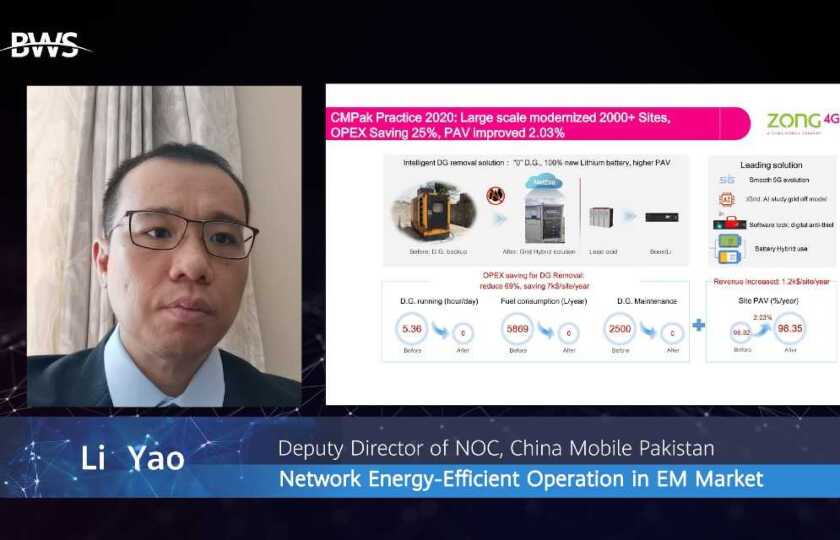Zong, the Pakistan mobile operator owned by China Mobile, is pursuing a vigorous campaign to improve its energy efficiency, ready for the introduction of advanced services on the network.
China Mobile bought the company, originally Paktel, in 2007. The company name is CMPak, but its national brand is Zong, and it operates 3G and 4G networks. At the same time, CMPak is getting ready for the introduction of 5G from 2023.
It is a market leader in 4G, with a 47.5% share in a market of four operators. The first 4G services started in 2014, and the company has established an absolute leadership position in 4G. Its aim is a continuous and stable operation in 2020, with the 4G customer penetration rate ranking number one in the industry, said Li Yao, deputy director of Zong, speaking at recent Huawei Better World Summit 2020 Power Digitalization 2025.
“We will focus on evolution of the 4G network and optimisation of network capacity,” he said at the conference.
But power is a challenge, he admitted. “The power solution is the foundation of the network,” he said. “We need to resolve bottlenecks in the power supply. And we need to carry out power supply modernisation on the sites in advance of rolling out 5G services on the network.”
At the same time as the challenges of upgrading first to 4G and then to 5G as well, there are power supply challenges in Pakistan, which is an emerging market.
“We will resolve these power supply issues in advance of 5G,” said Li.
The challenges lie in the fact that the cost of energy is increasing fast. Around 35% of sites need diesel generators and they consume 55% of the cost between them, with the other 45% of the energy budget being supplied from the grid.
But the grid is unstable, Li told the conference, with 35% of grid-connected sites facing outages of more than four hours a day. The lead-acid batteries needed for back-up are old, and 60% of sites go down because of battery issues. In addition, 35% go down because of diesel generator failures.
There’s low energy efficiency, Li noted, as power is wasted. Operation and maintenance costs are high. With manual control, reliability is low.
“To allow future network development we need many changes in the market,” said Li. “But for future evolution the cost of power and the battery is only the tip of the iceberg.” The power and the battery between them account for about 30% of the total cost. The other 70% goes on site acquisition, cranes, construction and other factors, including upgrading the electricity grid.
“We face a big challenge in site acquisition and upgrade,” he said. “The cost is increasing very fast.”
So CMPak is looking to the future, with the aim of achieving an efficient, digital and intelligent energy network.
The network needs to use big data and digitalization so it is visible, manageable, controllable and optimisable. Energy digitisation coupled with intelligent management brings three synergies – power, business and site. The site itself includes storage, cooling and other factors.
And then there’s the device, says Li. The whole technology takes into account a combination of sensors, connection, energy storage and digitalization.
“Digitalization can make the network manageable, visible,” says Li.
He summarises these in four steps for the network: diesel generator removal, digital network, an increase in power availability to 99.9% and then the adoption of green technology.
Removing the diesel generator will account for 30% saving in 2020, rising to 2023. The use of lithium batteries will also rise. And eventually solar power will add to the mix. “By 2023 we will have 50% green energy by solar power,” said Li.
The immediate aim is to cut the use of diesel generators from an average of 5.36 hours a day now to zero. At the moment generators use 5,869 litres a year. And they need maintenance. “The opex saving of 69% will save $7,000 per site per year,” said Li.
On the other hand, modern operations and management techniques and the use of lithium batteries will increase availability of the network so that revenue will go up by $1,200 per site per year,” he added.
“We want to build a visible, manageable and optimisable digital energy network, supporting the improvement of market operation, with smart decision-making and precise operations capabilities.”
This will mean CMPak will become “a global energy efficiency management benchmark”, he concluded. “We want to be a benchmark in emerging markets.”





